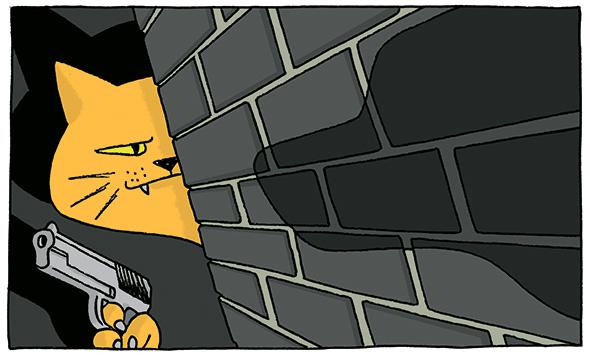From Sam Spade to Han Solo to Dr. Gregory House, a lot of our fictional heroes seem a little bit feline. They’re grumpy, they’re standoffish, they don’t buy into the system, they do things their way, and they’re pretty sure they’re in charge even if no one else agrees. So as strange as the conceit of Robert Repino’s post-apocalyptic detective novel Mort(e) initially seems, his loner hero comes to seem comfortably familiar as you read. Sebastian could easily have stepped out from the pages of Raymond Chandler … except that he’s a cat who can walk on two legs and shoot a gun.
House cat Sebastian’s human owner-family is an unhappy one. The dad drinks, the mom is having an affair with a neighbor. Every time the mom sneaks her paramour over, he brings his dog Sheba, who quickly becomes Sebastian’s first and only friend. Sebastian and Sheba’s interspecies platonic romance plays out against a background of increasingly ominous news reports on their owners’ TVs: whole cities in other parts of the world overrun by regular-sized ants, followed not long after by the appearance of extremely irregular-sized ants who can walk on their hind legs and kill humans by the city-full.
The “Change” happens to Sebastian just as the war arrives at his masters’ doorstep. He awakens one morning to hear two paradigm-shifting sounds: gunfire in the near distance … and human language he can understand. Now walking upright, Sebastian stops his psychologically shattered master from turning his gun on his own family, and then stops a family of passing sentient stray cats from executing his (now former) owners. In the chaos of this global animal uprising, however, he’s separated from his beloved Sheba. His quest to find her is cut short when he’s taken prisoner by—and eventually conscripted into—the Red Sphinx, an anti-human insurgency squad led by an upgraded bobcat named Culdesac.
It’s with Red Sphinx under Culdesac that Sebastian discards the house-cat name given to him by his human masters and takes on the moniker of “Mort(e).” The optional “e” in particular pleases him:
Sebastian based his name on a word he had come across in one of the old libraries. A word meaning death. He had died. He had killed. And he would kill again. So the name fit. But it could also be a normal name, the name of a regular guy named Mort who was meant for a life surrounded by loved ones. That life was still out there, but it would have to wait. Hence the need to keep the letter e in parentheses. Things could go either way. They could always go either way.

Photo by Nicholas Repino
It’s also during his military service with Red Sphinx that the reborn Mort(e) learns from his geeky feline brother-in-arms Tiberius the real story behind his remarkable transformation. It’s all due to the Colony, a subterranean hive-minded species of highly evolved ants, and in particular their giant Queen Hymenoptera, who has spent centuries underground developing the hormone that would transform the planet’s animals—and save Earth from the human race.
So yes, as you’ll have gathered, this novel is all kinds of crazy, but it wears its crazy so well. Repino maintains his deliriously deadpan confidence as he shifts Mort(e) from a war story to a detective story. After leaving Red Sphinx as an honored veteran and being given a cozy berth in his former master-family’s abandoned house, Mort(e) can’t settle into a comfortable postwar existence. Thoughts of his pre-Change canine friend still haunt him, thoughts that certainly aren’t diminished when someone scrawls “SHEBA IS ALIVE” on the wall of his basement. As rumors spread of a human-engineered disease called EMSAH, and as Mort(e) starts getting visits and signals from Homo sapiens survivors who regard him as some sort of savior, our cat-tagonist goes rogue to seek the truth once and for all.
Though the animals in this new regime are, by and large, glad to have shed the shackles of pet-hood, there are some elements of their former lives, flawed though they were, that they can’t leave behind. Repino suggests that the main thing sentience offers these once domesticated animals is clarification of what they value most, what they cling to and prioritize as the world goes mad around them. For Mort(e)’s partner, the pit bull Wawa, it’s the feeling of belonging to a pack. For Mort(e), no new possibility of attachment can eclipse or even rival his first experience of intimacy with Sheba. He doesn’t care about the Queen or the human remnants who oppose her. He just wants to see his friend again.
It’s a marvelously droll touch of Repino’s that the sort of interspecies friendship that people love to forward and coo over on social media provides the emotional engine of his post-apocalyptic epic. (This Kitten and This Puppy Wuv Each Other And Have Overthrown Their Human Masters: PHOTOS!) Indeed, a wonderful, low-key joke running throughout Mort(e) is how perfectly your average cat’s regally aloof, non-people-pleasing persona dovetails with the loner-sleuth-who-stands-apart-from-the-corrupt-society archetype of hardboiled detectives like Spade or Philip Marlowe. Any cat owner who’s wondered who’s actually calling the shots in the family will recognize Mort(e)’s steadfast refusal to ever do what any other character wants him to do or ever say what they want to hear. Ultimately Mort(e) can’t play for any team—the ants fthat want to perfect this world or the fanatic humans with their eyes on the next—for very long, which makes him the perfect hero to observe both sides—with the same baleful, dubious gaze I get when I try to persuade my cat to sit next to me on the couch. I hope she’ll spare me when the revolution comes.
—
Mort(e) by Robert Repino. Soho Press.
See all the pieces in this month’s Slate Book Review.
Sign up for the Slate Book Review monthly newsletter.
